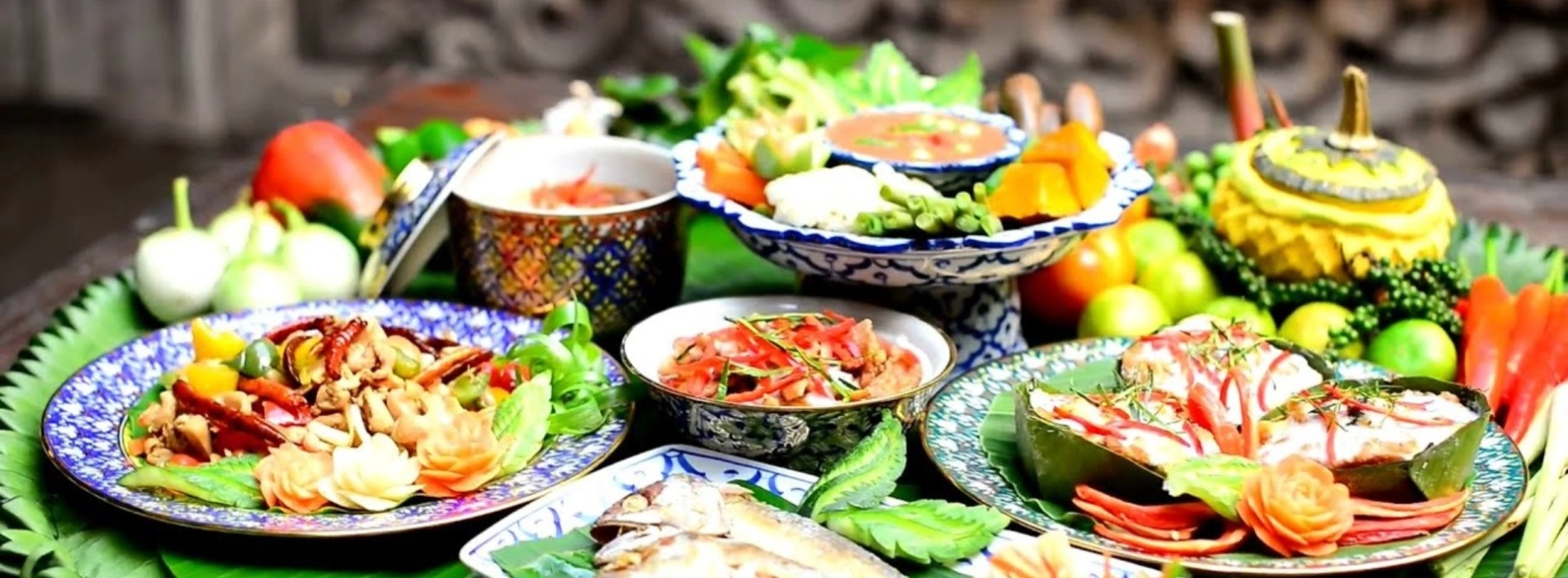
Thai cuisine has long been famous for its explosive flavors spicy, tangy, salty, and subtly sweet, but few realize that Eastern Thailand food offers an even bolder spectrum shaped by geography, Khmer heritage, and local wisdom. Unlike the hustle of Bangkok or the mountain vibes of Chiang Mai, the East is a land where the sea, forests, and Khmer cultural influences converge, creating a flavor map entirely its own.
Bordering Cambodia and hugging the Gulf of Thailand, Eastern Thailand includes four standout provinces: Chanthaburi, Rayong, Trat, and Chonburi (home to Pattaya). If Bangkok offers the “mainstream version” of Thai dishes for tourists, then the East delivers the deeper layer: food rooted in history, shaped by locals, and seasoned with secrets only native cooks truly master.

A vibrant Thai feast from Eastern Thailand
For culinary explorers, Eastern Thailand food opens up an entirely different side of Thai cuisine, more local, more bold, and deeply rooted in place.
Read more: Top 10 must-try dishes from Thailand
Each province contributes its unique flavor to the rich tapestry of Eastern Thailand food
Known for its gemstones, Chanthaburi food is a celebration of natural sourness, best represented by the iconic pork curry with chamuang leaves. The tangy young leaves blend with a light yet rich broth, tender pork melting on the tongue. One spoonful can warm you up on a rainy afternoon. Traditionally cooked for family gatherings, locals believe the sourness helps cool the body and soothe the spirit.
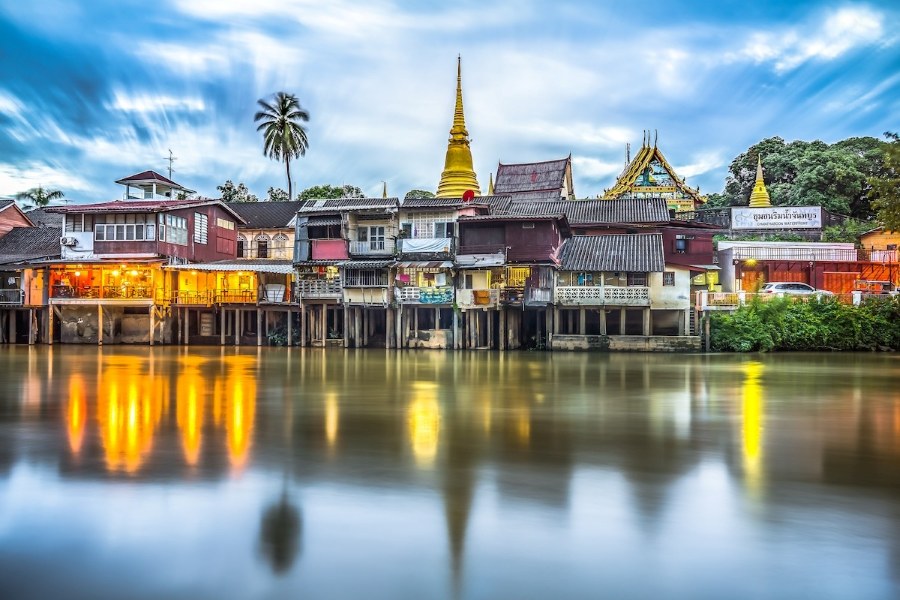
Chanthaburi
Don’t miss Sen Chan Pad Poo, a noodle dish that defines Chanthaburi food identity, chewy, crab-filled, and full of umami from the sea. The noodles are made from local rice, sun-dried for over 12 hours before cooking, giving them a uniquely chewy texture that holds the flavor beautifully.
Rayong seafood invites you to kick off your shoes, roll up your pants, and sit by the sea while savoring salt-grilled fish fresh from the Gulf. The fish is wrapped in a thick salt crust and grilled over hot coals, locking in its natural sweetness. It's served with a fiery seafood dipping sauce made with garlic, chili, lime, and fish sauce, bold and addictive.
.jpg)
Rayong
From grilled scallops to fiery raw shrimp, Rayong seafood captures the ocean’s boldest flavors with dishes you won’t find in inland kitchens. One bite and you're hit with a burst of cold sweetness from the shrimp, quickly followed by the punch of chili and garlic. You’ll either fall in love instantly or come back for a second bite just to adapt.
Trat's cuisine is the most homestyle in the East. Dishes like scallop curry, sour tamarind fish soup, and green crab salad are unpretentious, perfectly balanced, and feel incredibly real. Locals rarely use sugar, but instead skillfully balance flavors with pineapple, young tamarind, or lime peel, a quiet kind of sophistication you won’t find in cookbooks.

Trat
As someone once said, “Trat cuisine is like a Haiku, short, subtle, but lingers long after.”
A tourism hotspot, Chonburi offers everything from classic Thai to modern fusion. But tucked among the seafood restaurants, if you find a local spot serving traditional grilled fish salad (Larb Pla), you’ll understand why locals treat it almost like a ritual during family reunions.

Pattaya
As for dessert, skip the cakes. Go for Khao Lam sticky rice cooked inside bamboo tubes, drenched in coconut cream, sweet, fragrant, and the perfect way to end a culinary journey with a lingering pause.
Eastern Thailand is a region where the forest meets the sea, and that harmony lives in its food. Each dish is a reflection of tradition, local ingredients, and quiet mastery passed down through generations.
A hearty pork curry simmered with wild chamuang leaves, this is a staple of Chanthaburi cuisine. It’s served hot with rice and known for its rich, tangy broth that comes from the leaves, not coconut milk. Deeply comforting and full of earthy character.
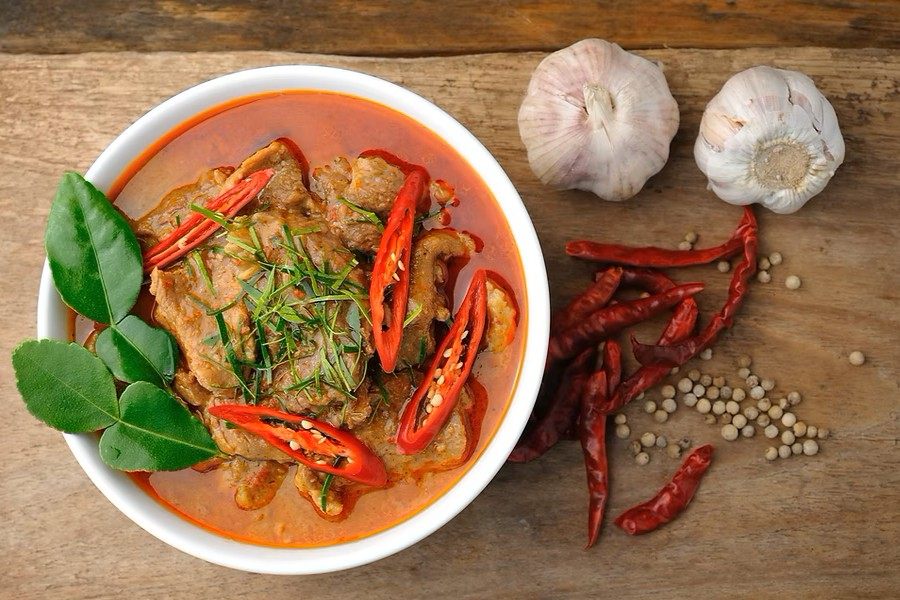
Kaeng Moo Bai Chamuang
Made with sun-dried rice noodles unique to Chanthaburi, this stir fry is tossed with fresh crab meat and savory seafood sauce. The noodles have a soft chew, the crab is sweet, and the whole dish tastes like a quiet afternoon by the coast.

Sen Chan Pad Pu
A whole fish is packed in coarse salt, grilled slowly over charcoal until the skin crisps and the meat inside stays moist. This Rayong classic is paired with spicy lime dipping sauce and best enjoyed fresh off the grill. Bold in its simplicity.
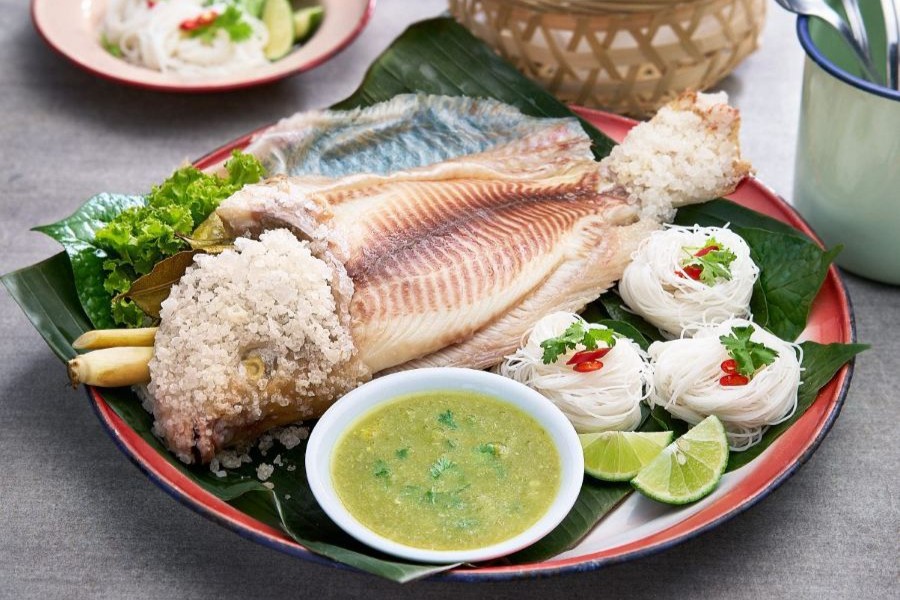
Pla Pao
Chilled raw shrimp served with a punchy mix of lime, garlic, chili, and fish sauce. This isn’t a gentle introduction to Thai food; it’s intense, refreshing, and electric. A favorite among locals who love bold flavors and serious heat.
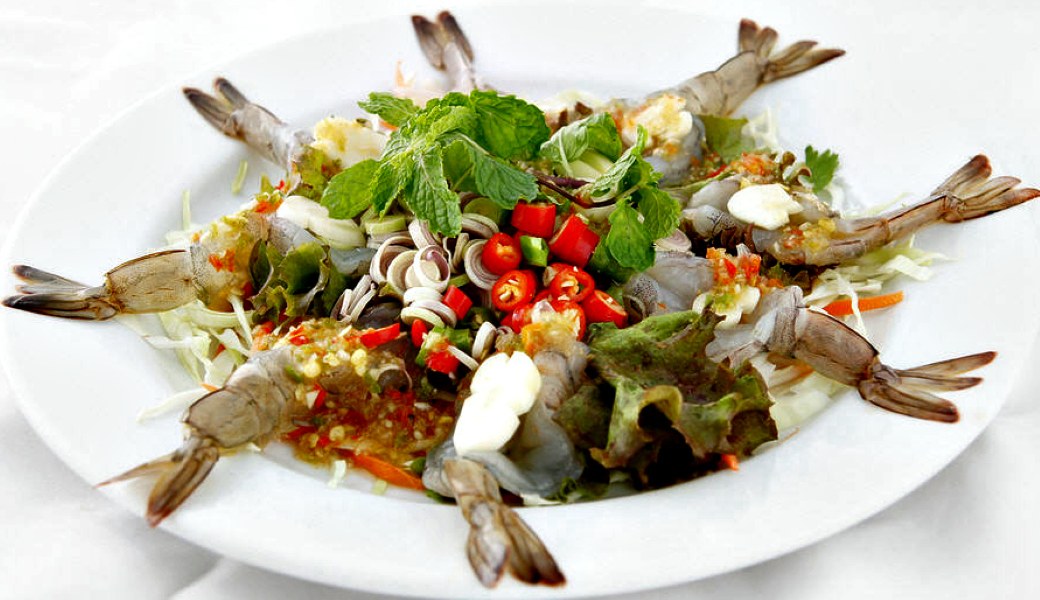
Goong Chae Nam Pla
These two dishes reflect the quiet elegance of Trat cuisine. The scallop curry is gentle but layered, while the crab salad brings a sharp, clean sourness with very little sugar. Nothing is overdone; everything is in balance.
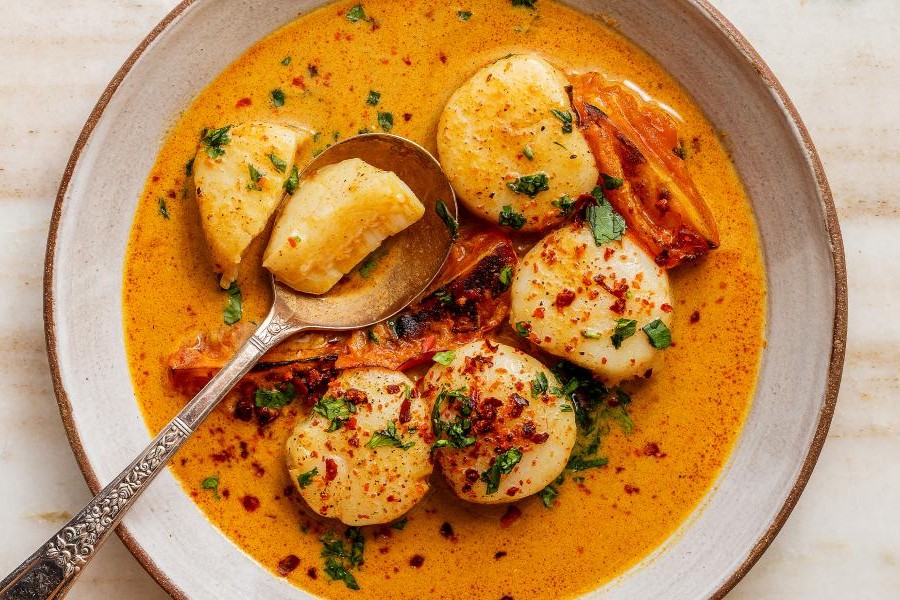
Trat Style Scallop Curry
Sticky rice mixed with coconut cream, packed into bamboo tubes, and roasted over an open fire. This dessert is found across Eastern Thailand, but especially beloved in Chonburi. Slightly smoky, lightly sweet, and soft to the bite. A calming end to a spicy meal.
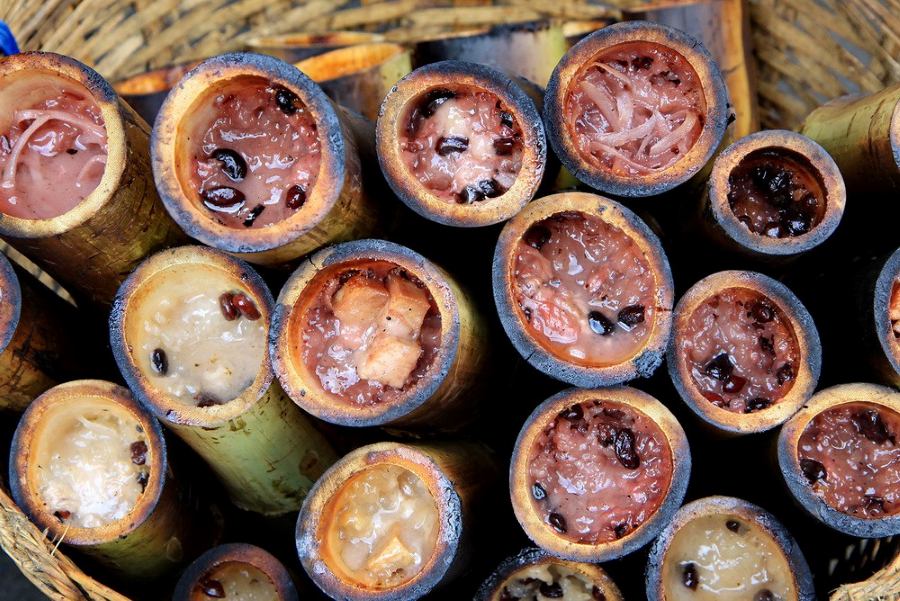
Khao Lam
These dishes go beyond taste. They carry stories of coastal life and forest foraging, of old family recipes and everyday resilience. They don’t shout for attention but stay quietly unforgettable in memory. That’s the essence of food from Eastern Thailand.
Beyond tourist menus and mass recipes, Eastern Thailand food follows nature, instinct, and legacy. Over time, as the flavors unfold and the layers reveal themselves, the true character becomes clearer, wild, intense, and unlike any other part of Thailand.
Eastern Thailand stretches across a land where the sea brushes against the forest, where rice fields coexist with jungle paths, and where the coastline fades into the horizon. This landscape shapes an incredibly rich source of ingredients:
The diversity of the land stamps a unique flavor on every dish, making this cuisine a true original.
Eastern Thai cooking rarely follows written recipes. Flavors come from instinct, memory, and tradition:
This fluid and personal approach gives the food a distinctive signature, setting it apart from the more standardized flavors found in commercial tourism.

Eastern Thailand food
Food in Eastern Thailand connects directly with the rhythm of daily life. Meals are moments of togetherness and reflection:
That’s the real charm of Eastern Thailand food, it reflects the life around it.
One of the most fascinating aspects of Eastern Thailand food is how it transforms with the weather.
Seasonal change not only affects ingredients but adds continual freshness to the culinary journey, keeping each visit exciting and memorable.
Food is more than just flavor. It’s about how a meal is shared, with whom, and where it happens. In Eastern Thailand, where cuisine has yet to be overly commercialized, the dining culture still preserves its subtle rules, emotions, and quiet charm.
A signature trait of this region is the way food is always enjoyed together.
Tip: When dining with locals or on a tour, observe how food is served. Thai people often use a clean spoon to serve from shared plates, never their personal chopsticks.
Eastern Thai food is known for its heat, but the spiciness here is more refined than in Bangkok or Isaan.
Tip: Not a fan of spice? Say “Mai Phet” (ไม่เผ็ด) which means "not spicy." Still, even this version can bring a surprising kick.

The colourful tradition saving Thailand's street vendors
Great food in Eastern Thailand isn’t limited to restaurants. It flows into the night markets, alleys, and waterfront stalls.
Tip: Look for stalls where locals are already eating. That’s often the clearest sign of quality.
In the East, especially in the mornings, meals are often quick and mobile.
Tip: Ask “Ni mi arai?” (มีอะไรบ้าง), which means “What do you have?” if no menu is displayed, and don’t hesitate to point at your choice.
Eastern Thai Food stands out with its refreshing sourness from local fruits, the incredible freshness of Rayong seafood, and the earthy tang of Chanthaburi food traditions rooted in forest ingredients. The bold harmony of sour, salty, sweet, and spicy awakens every sense. Let every trip be a chance to dive deeper into the stories and flavors of Eastern Thailand food
Read more: Thailand Tour 18 days: Heaven on the beach